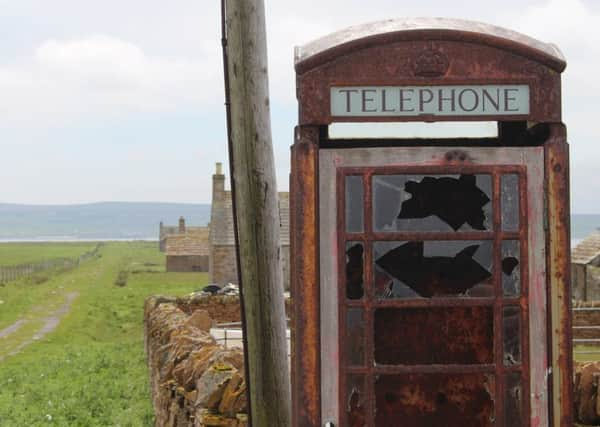The eerie still of the abandoned isle of Stroma


Once a vibrant community of “daring and skilful” islanders living amid the treacherous tides of the Pentland Firth, the settlement has sat empty since 1962.
It’s population stood at a peak of 375 in 1901 but fell away to just over 100 by 1949. By the early 1960s, just 12 people remained.
Advertisement
Hide AdAdvertisement
Hide AdDecay has since set in but a few powerful remnants of its human habitation are still to be found.
Many of the cottages still stand, albeit in various states of ruin. An old hand-cranked sewing machine can be found on the floor of one and a dresser – still holding a few metal storage tins – stands in the kitchen of another. Hearths are long empty.
The church still has its roof, but its windows have gone, and it is not known the last time the badly wrecked red phone box received a call.
Stroma, around two miles from John O’ Groats on the mainland, once had a shop, a school and a church with 50 cottages on the island.
A report in the John O’ Groat Journal in December 1859 noted there were no trees, shrubs or flowers on the island.
“Unadorned as it is, few of the natives would willingly leave it for a sunnier spot,” it added.
Crofting, cod and lobster fishing aided survival – as did the salvage of shipwrecks pulled from its battered shores with islanders making great gains from lost cargoes.
Storms were so fierce on Stroma that once waves crashed over the 100ft cliffs on the north side of the island leaving debris scattered across the land. For weeks at a time, Stroma could be cut off from the mainland by the weather.
Advertisement
Hide AdAdvertisement
Hide AdA newspaper article in 1949 reported a “Fag Famine” on the island after the island shop ran out of cigarettes during a bad spell of weather.
The island doctor, who would travel from John O’Groats by lifeboat to attend emergencies, could often find himself marooned – or unable to reach its residents at all.
The island is today owned by the Simpson family, who previously lived on Stroma, who bought it in 1960 to keep cows.
The purchase brought to an end a very peculiar spell in the island’s history.
Its previous owner, Yorkshire umbrella manufacturer John C Hoyland, had been trying to sell Stroma for several years. He bought it in 1946 for £4,000 but put it on the market four years later.
With a buyer hard to find, American television producer Robert Stivers bought an option to put Stroma – then home to three families – up as a prize on New York-based quiz show Bid ‘n Buy,
Following condemnation on both sides of the Atlantic, during which Mr Stivers was accused of being an American imperialist toying with the “peaceful people” of Stroma, the prize was withdrawn and an £8,000 car offered instead.
Depopulation intensified around the time of Hoyle’s ownership with sustainability of the island becoming increasing fragile despite a public investment of £30,000 in a new harbour.
Advertisement
Hide AdAdvertisement
Hide AdSome believe the harbour came too late -– while others think the employment it offered gave the means for some residents to leave. Both World Wars had also claimed the lives of a dozen island men.
A report in the Aberdeen Evening Express in September 1956 said: “It was through completion of the £30,000 harbour would halt depopulation. Such has not been the case. From the hundred inhabitants of a year ago the count is now down to 50 and in a very short time will be 45.
“Stroma has been unable to fulfil the need of livelihood and the drift to the mainland goes on. When the fishing fails in these small communities the crofting is not enough of itself to keep mind and body together.”
What remains today is a very poignant – and very silent – legacy of those people who called it home.